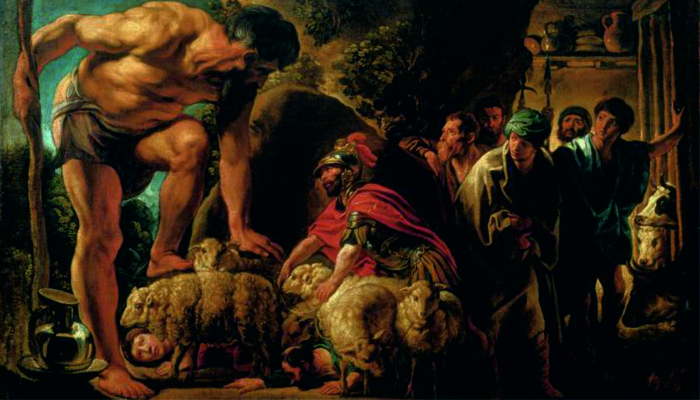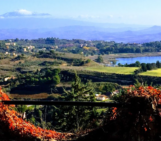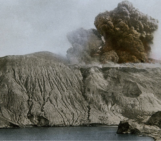
“Strangers, who are you? Where do sail from? Are you traders, or do you sail the as rovers, with your hands against every man, and every man’s hand against you?” … “Stranger, you are a fool, or else you know nothing of this country. Talk to me, indeed, about fearing the gods or shunning their anger? We Cyclopes do not care about Jove or any of your blessed gods, for we are ever so much stronger than they.” (Homer, Odyssey).
These are the very first words spoken by Polyphemus (a cyclops, son of Poseidon) to Ulysses in the Odyssey (the Homer’s masterpiece), after he landed on the slopes of Etna, close to the town of Aci Trezza in Sicily (Agnesi et al., 2007).
The Cyclopes
In Greek mythology, cyclopes were generally known as enormous, strong, and monstrous hugely tall men, with a single rounded eye located in the centre of their forehead (Fig. 1); indeed, the term Cyclops means “Circle-eyes” or “Round-eyes”(Perseus Project).

Fig. 1. Polifemo, by Giulio Romano in between 1526 and 1528, Sala di amore e psiche, Te Palace, Mantova, Italy.
However, they were not always depicted like Homer did, as to say living in caves, uncivilized and uncultured shepherds, savages with no regard for Zeus. Further Greek and Latin poets described the cyclops as very skilled, whose abilities have been extremally important for both the Gods and the men.
In the Theogony (Harvard), the most complete surviving Greek account of the origins and genealogy of the gods, Hesiod recounted how three cyclopes (Arges, Brontes, and Steropes) played a key role in the Gods war for their succession as the rulers of the Cosmos. The cyclopes, brothers of the Titans, were imprisoned by their father Uranus (the Sky God), who was then overthrown by his son Chronos. Freed by Zeus, son of Chronos, the cyclopes gifted him with the all-power thunderbolt, helping him in overthrown his father, making Zeus the final ruler of the Cosmos.
Following Hesiod’s Theogony, further poets such as Callimachus, Virgilio, and Ovid, described the cyclopes as skilled as to be the assistants of Hephaestus (Fig. 2a), God of Fire and Metalworking, in his forges below the Aeolian Islands and/or the Mt. Etna (see the previous post of the trilogy: “Vulcano, Vulcan’s forge”).
Thanks to their mythical strength, the cyclopes were also well known as master wall-builders, whose crafting can be found in several cities around Greece such as the Mycenaean walls of Mycenae, Tiryns, Argos, and of the Acropolis of Athens, nowadays known as the Cyclopean masonry (Fig. 2b).

Fig. 2. a) Forge of the Cyclopes, by Cornelis Cort in 1572, New Hollstein Dutch 209-2(4). b) Cyclopean Walls, Mycenae, Greece (Larry, Wikipedia Commons).
Although the cyclops are very interesting and controversial mythological characters, what if their existence represents one of the most beautiful and fascinating misunderstanding in human history?
The Cyclopes true nature
Cyclopes were hugely tall with a rounded eye in the centre of their forehead, thus if cyclopes ever existed, we should have found some huge skull with a hole in the centre of the forehead, and very long thick bones. This is exactly what it was widely found across the many caves of Sicily (Fig. 3a), and from those very remains the Greek myth came from (Agnesi et al., 2007).
However, during the Middle Ages, the myth transformed leading to the new idea of the existence of giants populating Sicily in ancient times, from whom the Sicilian population came from. One of the first reports of giant’s remains found in a cave, at the foot of Mt. Erice in Sicily (Fig. 3b), came from the “Genealogia degli Dei” (Genealogy of the Gods), written in 1365 by Giovanni Boccaccio (Boccaccio, 1365). In 1558, Tommaso Fazello, who is considered to be the father of Sicilian history, published “De Rebus Siculis Decades Duae” (Fazello, 1558), in which he asserted that the giants, identified with cyclopes, were the first inhabitants of Sicily, who started living inside mountain caves after the Flood. He also listed several places where giant bones were found, such as on Mt. Etna, or in caves close to Palermo, Siracusa and Caltanissetta.

Fig. 3. a) comparison between the dwarf elephant reported in Pohlig, 1893 and the Polyphemus’ head (Second century BC. In Boston, Museum of Fine Arts). b) The giant of Erice by Atanasio Kircher, Mundus Subterraneus, Amsterdam, 1678. (After Agnesi et al., 2007).
In April 1830, the creationist Baron Antonio Bivona Bernardi marked the birth of vertebrate palaeontology in Sicily, with the publication of “La Cerere” in the Giornale Ufficiale di Palermo (Bernardi, 1830). Here, he associated the remains found in the caves to various vertebrate animals such as hippos, elephants, giant deer, tapir, and horses, extinguished after the Flood. A second big turn to the cyclopes’ myth, was made by Vaufry (1929), who formulated a new theory based on both his studies and on the findings by H. Falconer and H. Pohling (Falconer, 1868; Pohlig, 1893). He suggested that the fossil elephants discovered in Sicily belonged to four different species, characterized by different sizes, who descended from the European elephant (“Elephas” antiquus). From bigger (i.e., older species) to smaller (i.e., younger species) they were subdivided in: Elephas antiquus, Elephas mnadriensis, Elephas melitensis and Elephas falconeri (aka pygmy elephant). That was a huge discovery, since he presented an amazing record of progressive reduction of size due to insularity conditions characterized by the lack of predators and the limited genetic exchange, well in agreement with the growing evolutionary Darwinian vision. A further evolution of such theory was subsequently made by Ambrosetti (1968), who suggested the occurrence of only three species, Elephas antiquus, Elephas mnadriensis, and Elephas falconeri and a strong sexual dimorphism for the latter.
Finally, the last big scientific jumps came from the absolute dating of some elephant’s molars by Bada and Belluomini (1985) and by the stratigraphic record found in a travertine quarry of Alcamo town by Burgio and Cani (1988). According to the absolute dating, subsequently confirmed by the stratigraphic records, Elephas falconeri lived around 500.000 years ago, while Elephas mnadriensis lived about 230.000 years ago (Fig. 4).

Fig. 4. Size comparison between the ancestor Elephas antiquus (a), the Late Pleistocene –Holocene Elephas falconeri found in Talos (Greece) (b), the modern Asian Elephant (c), and a modern person in black. Modified after Masseti (2001). d) The reconstructed skeleton of a Elephas falconeri, at Senckenberg Museum of Frankfurt.
They swept away the hypothesis of a progressive reduction in size, introducing a more articulate evolution for the Sicilian environment and faunal dispersal, influenced by geological phenomena such as tectonic movements and eustatic oscillation of the sea level in the last 800.000 years. The different animal population reached Sicily and other Mediterranean islands, when they were connected with continental Italy and Europe; among them there were the elephants coming from Asia, who populated continental Europe during the Quaternary. The subsequent biogeographic isolation of Sicily, Malta, and other islands of the Mediterranean Sea (Athanassiou et al., 2019), caused the development of dwarfism, also favoured by the size of the islands, the lack of predators, the presence of ecologically relevant competitors and the time in isolation. All these species are today included within the genus Palaeoloxodon, after having realized that they have not direct phylogenetic relationships with the extant Asian elephant, Elephas maximus (Meyer et al., 2017).
References
Agnesi, V., C. Di Patti, B. Truden, 2007. Giants and elephants of Sicily. In Piccardi, L. & Masse, W.B. (Eds), Myth and Geology. Geological Society, London, Special Publications 273, 263 – 270.
Ambrosetti, P., 1968. The Pleistocene dwarf elephants of Spinagallo (Siracusa, South-Eastern Sicily). Geologica Romana, 7, 277-398.
Athanassiou, A., A. A. E. van der Geer, G.A. Lyras, 2019. Pleistocene insular Proboscidea of the Eastern Mediterranean: A review and update. Quaternary Science Reviews 218, 306 – 321. doi:10.1016/j.quascirev.2019.06.0.
Bivona Bernardi, A., 1830. Breve relazione sugli ossi fossili trovati non a guari vicino Palermo. La Cerere, Giornale Officiale, Palermo.
Boccaccio, G., 1365. La Genealogia degli Dei. Venezia.
Falconer, H., 1868. On the ossiferous grotta di Maccagnone near Palermo. Paleontological Memoirs and Notes, London 2, 543 – 553.
Fazello, T., 1558. De rebus siculis decades due. Fiorentino, R. (trans.) Palermo, 1830/1831.
MIT University. http://classics.mit.edu/Homer/odyssey.mb.txt. Consulted on 11/07/2022.
Masseti, M. Did endemic dwarf elephants survive on Mediterranean islands up to protohistorical times? The World of Elephants International Congress, Rome (Italy), 2001.
Pohlig, H., 1893. Eine Elephantenhole Siciliens und der erste Nachweis des Cranialdomes von Elephas antiquus. Abhandlungen der KOniglich Baierischen Akademie der Wissenschaften, 2 KI., Bd. 18, Abth., Munchen.
Tufts University. https://www.perseus.tufts.edu. Consulted on 11/07/2022.
Vaufrey, R. 1929. Les dlephants nains des iles mdditerrandennes et la question des istmes pleistocdns. Archives de L’Institut de Pal6ontologie Humaine, Paris 6, 1 – 220.




